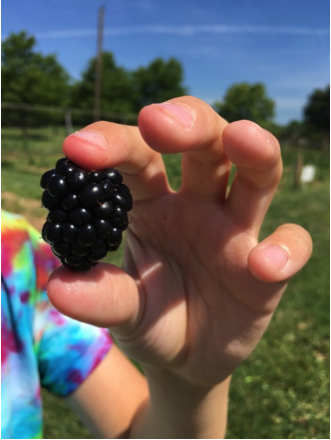Driving into church and glancing to your right, the farm looks pretty wonderful. Orderly rows, mowed grass paths, tomato cages standing tall, like a postcard of an old-fashioned Victory Garden. It doesn’t just look wonderful, it is wonderful. When you enter the garden gates and start to walk the rows, though, the gloss of order falls away. Here the weeds have overtaken the lettuce, and you can’t see their soft green heads anymore. There are bugs on the eggplant, and the leaves have been reduced to a fine lace. The cucumbers vines are lazing about rather than hoisting themselves up their lovingly constructed trellis. Up close the garden is weird and messy and very, very alive.
There are gardens that are as neat up close as they are when viewed from the road. The plants are spaced exactly, the soil between the plants is bare of weeds, and there are no bugs. The big farms that grow most of our food are sometimes that way, planted with GPS enabled equipment and sprayed regularly to kill weeds and bugs alike. The amount of food that comes from farms like that is amazing, and to some extent we could run our garden on that model, scaled down to our size: roto-tilling weekly for weeds, spraying insecticide frequently, taking seed packets out of the hands of enthusiastic 5 year olds who sprinkle too thickly, or not at all. Perhaps we’d produce more food, but other things would be lost.
Throw away the ideal Victory Garden postcard, and this is what you can see in our garden instead. Over there is the kale bed, which was dug and shaped by volunteers from Walter Reed with rigor and precision. On the other side is a bed of beets, the plants straggling across the row grouped and bunched a little haphazardly. A child planted that row, and it is beautiful. Maybe that child will come back, see his beets, and take one home to try. Or maybe not. It is beautiful still. And over there, in the tomato bed, you will see the interplay of predator and pest, eater and eaten, if you dare to look closely this summer. A beautiful, grotesque creature called the Tomato Horn Worm will begin to eat our tomato plants very soon. If you see one, look at its back. If it is looks like it is wearing a mohawk made up of white ovals, it has been parasitized by the Braconid Wasp, an insect that also kills the flea beetles that turn our eggplants to lace. We too eat and are eaten, and a living garden is a reminder that any meal is sacred, made up as it is of death and life endlessly intertwined.
Finally, if you end up in the back rows of the garden, you will see the berries. Right now the blackberries are sweet and ripe. There aren’t enough of them for a pie or jam or even a fruit salad. There are just enough for gardeners to slip past the billowing weeds and the munching horn worms, pull a few berries from their canes, and eat them amid the rambunctious rows, enjoying the sweetness and the moment of rest.

